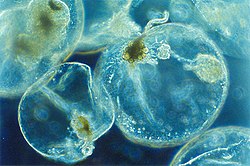| Dinophyceae | |
|---|---|
 | |
| Noctiluca scintillans , dinoflagellate that exhibits bioluminescence | |
| Scientific classification | |
| Domain: | Eukaryota |
| Clade: | Sar |
| Clade: | Alveolata |
| Clade: | Dinozoa |
| Phylum: | Dinoflagellata |
| Class: | Dinophyceae Pascher, 1914 |
| Orders | |
Dinophyceae is a class of dinoflagellates. [1] [2] [3]